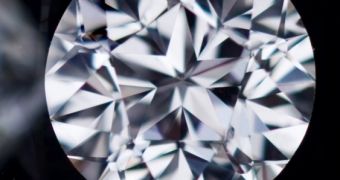Peanut butter is a favorite breakfast and snack for many Americans, and not only for them. The food paste, made primarily from ground roasted peanuts, with or without added oil, was first used by the Pre-Columbian peoples of Mexico, who used it as a base for various "moles", meaning sauces.
Now, a team of scientists presented the most recent and spectacular use of peanut butter ever. They have proven it's possible to turn the common peanut butter into the most expensive gems in the world, diamonds.
The formation of a natural diamond requires very specific conditions, like exposure of carbon-bearing materials to high pressure, ranging approximately between 45 and 60 kilobars, but a comparatively low temperature range between approximately 1600-2370F (900-1300C). These conditions are known to be met in two places on Earth: the litospheric mantle below relatively stable continental plates, and at the site of a meteorite impact.
Professor Malcolm McMahon, based at the Centre for Science and Extreme Conditions at Edinburgh University, said that his team of scientists can replicate these extreme conditions, by squeezing the peanut butter between the tips of two diamonds, thus producing a "stiletto heel effect".
"Obviously large gem-quality diamonds would be extremely expensive, so we are looking at ways to make them artificially," he said. "Many carbon containing materials can be converted into diamond including peanut butter."
He sustains that huge pressure is all that it takes to transform ordinary elements into new materials, thus proving that the century-old dream of the alchemists is really possible.
"Pressure can cause extraordinary changes in all kinds of materials and can create completely novel materials," the professor added. "We are currently developing techniques that will create pressures of up to five million atmospheres, much higher than the pressure at the center of the earth, to find the holy grail of high-pressure physics, the metallic phase of hydrogen."
Metallic hydrogen is obtained when hydrogen is compressed sufficiently to undergo a phase change. In it, the electrons are unbound and behave like the conduction electrons in a metal do. "If we manage to make metallic hydrogen, the next step will be to make enough to study it in real detail, which would mean using much larger diamond anvils, about the size of your thumb, to squeeze it."

 14 DAY TRIAL //
14 DAY TRIAL //